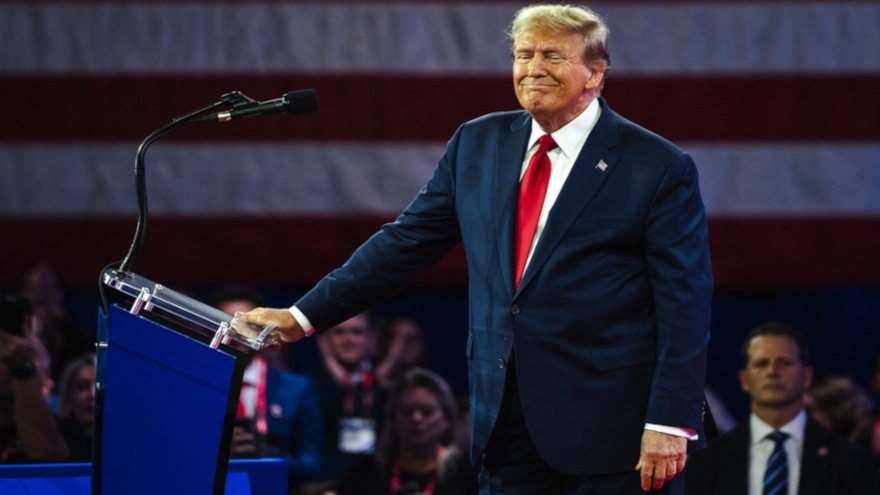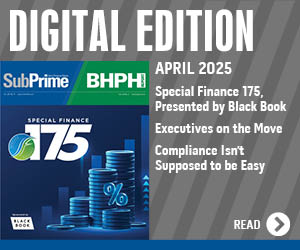Experts give auto-finance outlook after another Fed rate cut & Trump election victory

Donald Trump is pictured at a campaign event in National Harbor, Md., in February. Trump was elected to another term as president on Tuesday. Image by Jonah Elkowitz / Shutterstock.com.
It’s been a busy week. Donald Trump claimed victory in his bid to return to the White House on Tuesday, and the Federal Reserve cut interest rates again on Thursday.
Those developments might not directly impact the vehicles your dealership turns and your finance company underwrites in the immediate future. But experts from inside and outside automotive see the potential for many shifts down the road.
As what Comerica Bank said was virtually assured, the Fed lowered the federal funds target a quarter percent to a range of 4.50% to 4.75% two days after the election. The cut of 25 basis points came after policymakers trimmed rates by 50 basis points in September.
“As the economy evolves, monetary policy will adjust in order to best promote our maximum employment and price stability goals,” Fed chair Jerome Powell reiterated on Thursday. “If the economy remains strong and inflation is not sustainably moving toward 2 percent, we can dial back policy restraint more slowly. If the labor market were to weaken unexpectedly or inflation were to fall more quickly than anticipated, we can move more quickly.
“Policy is well positioned to deal with the risks and uncertainties that we face in pursuing both sides of our dual mandate,” Powell continued.
How well positioned is the automotive industry to put someone in a car they can afford? Let’s get into the numbers shared this week by Cox Automotive and Edmunds.
Through his blog posted after the Fed announcement, Cox Automotive chief economist Jonathan Smoke indicated rates finance companies are booking for new-car paper to start November are down by 30 basis points year-over-year and 55 basis points for used-car contracts. Smoke pointed out that it’s now three months in a row where those trends are lower compared to the previous year.
“Many lenders have room to cut yield spreads by about a point just to get back to average. In other words, they can get more aggressive on rate without really being aggressive,” Smoke said. “Lenders will be willing to do that if they feel better about the economy and loan performance. In addition, captives have room for incentive growth relative to vehicle prices. They have been remarkably disciplined so far this year with financing offers, but I suspect that may change soon.
“I expect the best time for lower rates will be by the spring. Loan performance should improve by then and the Fed will likely have lowered another 50 basis points. As a result, consumers could see 1-1.5 points of further improvement, more on used vehicles and more on captive new-vehicle deals,” he continued.
“I suspect some lenders will be willing to get aggressive before year end,” Smoke went on to say. “We will be keeping a sharp eye on rate trends and incentives. Captives and auto-focused finance companies will likely be the first to move aggressively.”
A day before the Fed’s decision, Edmunds shared a variety of finance-related data generated in October, including:
—Average APR: New: 7.0%; Used: 11.1%
—Average Monthly Payment: New: $742; Used: $551
—Average Amount Financed: New: $41,362; Used: $28,458
—Average Interest Paid: New: $8,981; Used: $10,233
—New-vehicle average transaction price (ATP) was $47,612 in October 2024
—New vehicle ATP increased 26% from 2019 and by 37% since 2016; the former being a data point when President-elect Trump was in office
Edmunds also recapped its latest information about consumer sentiment data on affordability. Edmunds conducted a survey in August among car shoppers who have purchased a vehicle previously and have indicated they are planning on purchasing a vehicle in the next 12 months.
Researchers found:
—73% say they have held off buying a new vehicle because of high vehicle prices
—62% say they have held off buying a new vehicle because of high interest rates
—37% say they are waiting for the election results (before purchasing my vehicle)
—64% say if the Federal Reserve were to cut interest rates, this would affect the timing of a car purchase
“A number of issues have been the subject of debate during this election cycle, but affordability has bubbled to the top of the list of concerns for many Americans,” Edmunds head of insights Jessica Caldwell said on Wednesday. “Consumers across the country have felt the weight of the rising cost of living compounded by high interest rates, making everyday expenses and non-negotiable purchases like reliable transportation increasingly difficult to manage.
“Amid this economic strain, it’s clear that President Trump’s promises of financial relief resonated with voters across the country,” Caldwell continued. “As Americans seek a reprieve from the relentless pressures on their wallets, even a modest federal rate cut would be seen as a positive step in the right direction.”
And with voters choosing to put Trump back in the White House, even more change involving interest rates and metrics associated with finances could be in the offering. Comerica Bank chief economist Bill Adams and senior economist Waran Bhahirethan offered a few predictions.
“In short, the Fed followed through with the cut signaled at the September decision but was a little less adamant about the case for additional rate cuts in December and into 2025. Powell did state that the Fed is still ‘on a path toward a more neutral stance.’ But neutral is a theoretical idea, not a specific level,” Adams and Bhahirethan said.
“President-elect Trump is likely to pressure the Fed to cut interest rates more aggressively, like he did during his first term, but at least over the next year it will have little effect on the trajectory of interest rates. The Fed system is structured to insulate rate decisions from pressure from the White House,” Adams and Bhahirethan continued. “After Fed chair Powell’s term expires in 2026, President-elect Trump will have an opening to appoint a new Fed chair who is more sympathetic to his calls for lower interest rates.”


